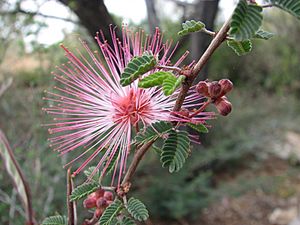Fairy duster facts for kids
Quick facts for kids Fairy duster |
|
|---|---|
 |
|
| Scientific classification | |
| Genus: |
Calliandra
|
| Species: |
eriophylla
|
| Synonyms | |
|
|
The fairy duster (scientific name: Calliandra eriophylla) is a small, spreading shrub. It grows naturally in the deserts and dry grasslands of the southwestern United States and Mexico. You can find it in states like California, Arizona, New Mexico, and Texas.
Its beautiful flowers appear from late winter to late spring. They have many pale to deep pink parts called stamens. Each flower cluster is about 5 centimeters (2 inches) wide.
This shrub usually grows between 20 and 50 centimeters (8 to 20 inches) tall. It has special leaves that are divided into many small leaflets. People also call this plant mock mesquite or mesquitella.
Contents
What is the Fairy Duster Plant?
The Calliandra plant family has over 250 different types. Only three of these types grow naturally in the southwestern United States. The fairy duster is one of them. It is found in places like the Sonoran and Chihuahuan deserts in northern Mexico. You can also see it in southern California and southwestern New Mexico.
This amazing plant gets its name because of its "showy appearance." Calliandra plants love hot weather. Once they are fully grown, they can survive very long dry periods. They can even live if they are watered only once or twice a week.
Where Does the Name "Fairy Duster" Come From?
The scientific name Calliandra means "beautiful-stamens." This refers to the plant's pretty, brush-like flowers. The second part of its name, eriophylla, comes from Greek words. It means "wooly leaf," describing its fuzzy leaves.
This plant has many common names. Some of these include false mesquite, stickpea, and pink mimosa. In Spanish, it is called plumita, gavia, and cabeza angel.
How to Identify a Fairy Duster Plant
The fairy duster is usually a low-growing plant. In higher places, it spreads out close to the ground. In lower areas, it grows upright and bushy. A mature fairy duster can reach heights of 1.2 to 1.5 meters (4 to 5 feet). It can also spread twice as wide.
You don't usually need to trim this plant. But if you do prune it, the plant can become much thicker and denser. The fairy duster has round flower clusters. These flowers can be cream, pink, or white. Each cluster is about 3 to 5 centimeters (1.25 to 2 inches) across. They contain many long, thin stamens. These stamens are usually straight, but sometimes they can be curled.
Where Does the Fairy Duster Grow?
Calliandra eriophylla typically grows in dry places. The fairy duster can survive with very little water. It also does well with different amounts of sunlight. However, it blooms more flowers when it gets a lot of sun.
This plant needs soil that is dry and has gravel. It also prefers soil that is naturally alkaline. You can often find it on open hillsides and desert washes. It grows on slopes below 1,500 meters (5,000 feet) in elevation. These plants can grow to be 60 to 120 centimeters (2 to 4 feet) wide. They can also reach 30 to 90 centimeters (1 to 3 feet) tall. During spring and summer, the plant produces pale to bright pink flowers.
Where Can You Find Fairy Duster Plants?
Calliandra eriophylla grows across many dry areas. It is most common in the southwestern United States and northern Mexico. This includes southern California, New Mexico, Texas, and Arizona.
These plants are native to the Arizona region. This means they can survive in desert areas with very little water. They thrive in places like the Mohave Desert and Sonoran Desert. They also grow well in other areas with similar weather to southern Arizona. The best elevation for fairy duster to grow is between 300 and 1,500 meters (1,000 and 5,000 feet).
How Fairy Duster Reproduces and Gets Pollinated
The fairy duster is quite common in the deserts of the southwestern United States. Because of this, many different animals help pollinate it. Some of the main pollinators are bees, flies, butterflies, and hummingbirds.
The fairy duster attracts these pollinators by making a lot of nectar. Each flower produces about 2.17 milligrams of sugar. This pollination helps the plant's seed pods start to grow. When the pods are ready, they break open. They then launch the seeds to spread the plant. One problem for the seeds is that many animals eat them. Small birds like quails might even open pods before they pop.
Animals That Interact with Fairy Duster
The pale pink flowers of the fairy duster attract many desert animals. This plant becomes a food source for deer living in the desert or on hillsides. When the flowers are blooming, they also attract butterflies and hummingbirds. The plant provides nectar for animals that feed on it, such as hummingbirds and bees.
See also
 In Spanish: Barba de chivo o charrasquillo para niños
In Spanish: Barba de chivo o charrasquillo para niños


